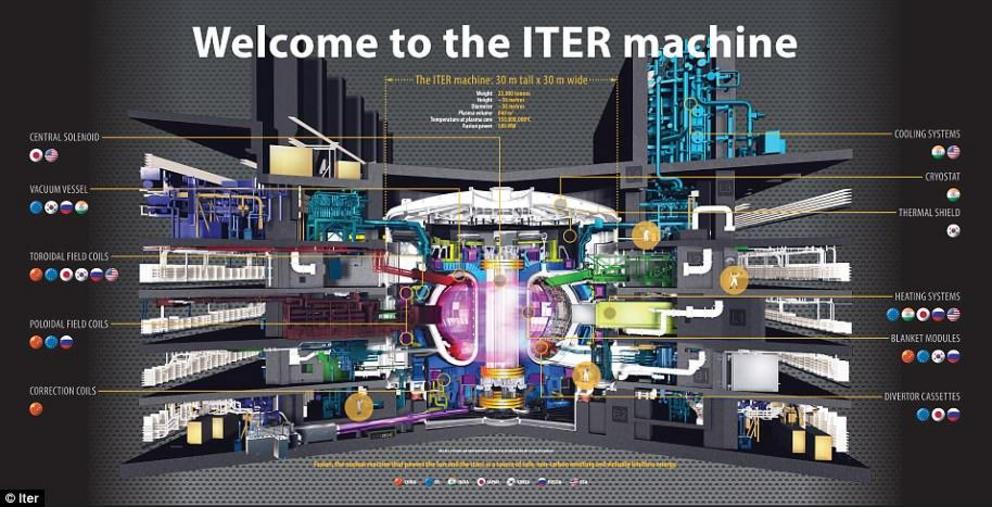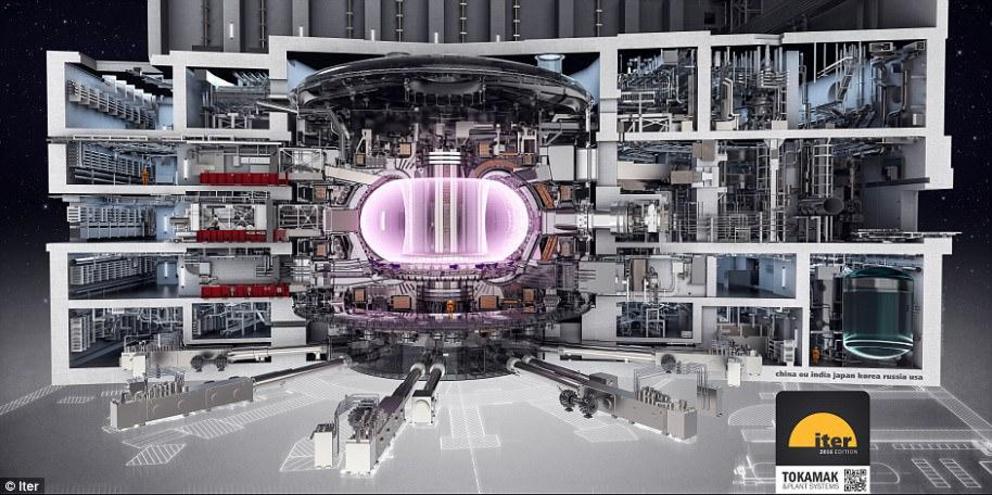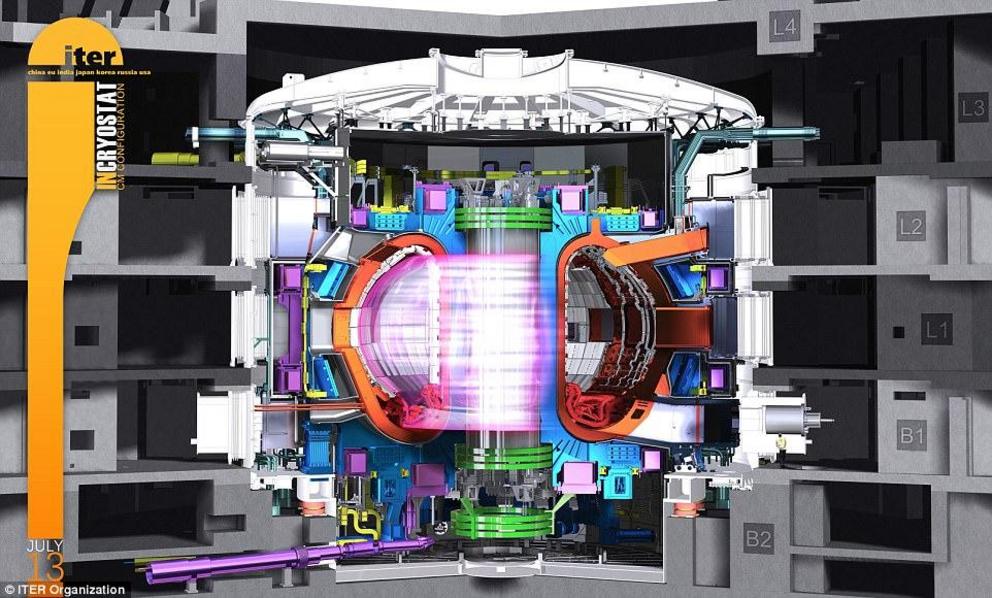The AI that could help make limitless fusion power a reality
An AI is set to try and work out how a potentially limitless supply of energy can be used on Earth.
It could finally solve the mysteries of fusion power, letting researchers capture and control the process that powers the sun and stars.
Researchers at the U.S. Department of Energy's (DOE) Princeton Plasma Physics Laboratory (PPPL) and Princeton University hope to harness a massive new supercomputer to work out how the doughnut-shaped devices, known as tokamaks, can be used.

In the middle of the rising Tokamak Building a well is preserved for the ITER machine. While ITER won't generate electricity, scientists hope it will demonstrate that such a fusion reactor can produce more energy than it consumes. Assembly activities will proceed in a bottom-up fashion, beginning with captive components down in the basement levels, then the base of the cryostat, vacuum vessel sectors, magnets and an estimated one million components (ten million individual parts) will be integrated into the world's largest tokamak.
FUSION POWER EXPLAINED
Fusion involves placing hydrogen atoms under high heat and pressure until they fuse into helium atoms.
When deuterium and tritium nuclei - which can be found in hydrogen - fuse, they form a helium nucleus, a neutron and a lot of energy.
This is down by heating the fuel to temperatures in excess of 150 million°C, forming a hot plasma.
Strong magnetic fields are used to keep the plasma away from the walls so that it doesn't cool down and lose it energy potential.
These are produced by superconducting coils surrounding the vessel, and by an electrical current driven through the plasma.
For energy production. plasma has to be confined for a sufficiently long period for fusion to occur.
Researchers have struggled with disruptions that can halt the reactions and damage the devices.
Now an artificial intelligence system that can predict and tame such disruptions has been selected to be one of the first projects to run on the Aurora supercomputer, which is set to become the first U.S. exascale system upon its expected arrival at Argonne in 2021.
The system will be capable of performing a quintillion (1018) calculations per second — 50-to-100 times faster than the most powerful supercomputers today.
'Our research will utilize capabilities to accelerate progress that can only come from the deep learning form of artificial intelligence,' said William Tang, a principal research physicist at PPPL.
The groundbreaking project will try and develop a method that can be experimentally validated for predicting and controlling disruptions in burning plasma fusion systems such as ITER — the international tokamak under construction in France to demonstrate the practicality of fusion energy.
ITER is the most complex science project in human history.
The hydrogen plasma will be heated to 150 million degrees Celsius, ten times hotter than the core of the Sun, to enable the fusion reaction.
The process happens in a donut-shaped reactor, called a tokamak,1 which is surrounded by giant magnets that confine and circulate the superheated, ionized plasma, away from the metal walls.
The superconducting magnets must be cooled to minus 269°C, as cold as interstellar space
INSIDE THE ITER: HOW IT CREATES ENERGY
ITER uses a strong electric current to trap plasma inside a doughnut-shaped device long enough for fusion to take place.
The device, known as a tokamak, was conceived by Soviet physicists in the 1950s. But it's proving tough to build, and could be even tougher to operate.

The project's members - China, the European Union, India, Japan, South Korea, Russia and the United States - settled on a design that uses a doughnut-shaped device called a tokamak to trap hydrogen that's been heated to 150 million degrees Celsius (270 million Fahrenheit) for long enough to allow atoms to fuse together.
Iter nuclear engineers have recruited rocket scientists to help create super-strong materials that can withstand temperatures hotter than the sun.
The Iter team claim a technique for building launcher and satellite components has turned out to be the best way for constructing rings to support the powerful magnetic coils inside the machine.

The Tokamak and its plant systems housed in their concrete home. An estimated one million parts will be assembled in the machine alone. Image format: 72dpi - 4500 px width.
Spanish company CASA Espacio is making the rings using a method they have perfected over two decades of building elements for the Ariane 5, Vega and Soyuz rockets.
'Forces inside ITER present similar challenges to space,' explains Jose Guillamon, Head of Commercial and Strategy.
'We can't use traditional materials like metal, which expand and contract with temperature and conduct electricity.
'We have to make a special composite material which is durable and lightweight, non-conductive and never changes shape.'
The magnets themselves are massive. Engineering & Technology reports that the one currently being built is 45 feet long, 30 feet wide, and 3 feet deep.

Iter nuclear engineers have recruited rocket scientists to help create super-strong materials that can withstand temperatures hotter than the sun. With a diameter of 5 m and a solid cross-section of 30x30 cm, Iter's compression rings will hold the giant magnets in place.
The final design will use 18 of these magnets, each weigh between 113,400kg and 226,800kg (250,000 and 500,000lbs)—which is about the same as a Boeing 747 airplane.
CASA Espacio has been at the forefront of developing a technique for embedding carbon fibres in resin to create a strong, lightweight material to hold these magnets.
The composite is ideal for rocket parts because it retains its shape and offers the robust longevity needed to survive extreme launches and the harsh environment of space for over 15 years.
Scientists have long sought to mimic the process of nuclear fusion that occurs inside the sun, arguing that it could provide an almost limitless source of cheap, safe and clean electricity.
Unlike in existing fission reactors, which split plutonium or uranium atoms, there's no risk of an uncontrolled chain reaction with fusion and it doesn't produce long-lived radioactive waste.
The PPPL/Princeton deep-learning software is called the 'Fusion Recurrent Neural Network (FRNN),' and is composed of neural nets that allow a user to train a computer to detect items or events of interest.
The software will be trying to speedily predict when disruptions will break out in large-scale tokamak plasmas, and to do so in time for effective control methods to be deployed.
The overall goal is to achieve the challenging requirements for ITER, which will need predictions to be 95 percent accurate with less than 5 percent false alarms at least 30 milliseconds or longer before disruptions occur.
Video can be accessed at source link below.

